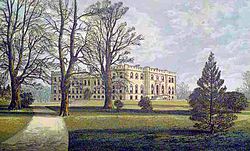| Kimbolton Castle | |||||||||||||||||||||||||||||||||||||||||||||||||
|---|---|---|---|---|---|---|---|---|---|---|---|---|---|---|---|---|---|---|---|---|---|---|---|---|---|---|---|---|---|---|---|---|---|---|---|---|---|---|---|---|---|---|---|---|---|---|---|---|---|
 The castle in 2011 The castle in 2011
| |||||||||||||||||||||||||||||||||||||||||||||||||
| |||||||||||||||||||||||||||||||||||||||||||||||||
 | |||||||||||||||||||||||||||||||||||||||||||||||||
Kimbolton Castle is a country house in Kimbolton, Cambridgeshire, England. It was the final home of King Henry VIII's first wife, Catherine of Aragon. Originally a medieval castle but converted into a stately palace, it was the family seat of the Earls and Dukes of Manchester from 1615 until 1950. It now houses Kimbolton School.
History


The castle was built by Geoffrey Fitz Peter, 1st Earl of Essex, in the late 12th century. The inner court was rebuilt by Anne, Duchess of Buckingham, in the late 15th century.
The castle was acquired by Sir Richard Wingfield in 1522. Catherine of Aragon was sent here in April 1534 for refusing to give up her status or deny the validity of her marriage. In July 1534, a fool in the retinue of the diplomat Eustache Chapuys tried to swim the moat, drawing attention to her imprisonment. The fenland climate damaged her health, and she died in the castle on 7 January 1536.
The castle was bought by Sir Henry Montagu, later created 1st Earl of Manchester, in 1615. The 4th Earl of Manchester, who was created 1st Duke of Manchester in 1719, had many works of reconstruction carried out between 1690 and 1720. These works included the rebuilding of the south wing, which had fallen down, to a design by Sir John Vanbrugh. The 4th Duke of Manchester commissioned Robert Adam to design the gatehouse which was constructed in 1766.
Many members of the Montagu family (Earls and Dukes of Manchester) are buried at St Andrew's Church in Kimbolton. Several Montagu monuments still exist in the South Chapel, while the Montagu vault (extended in 1853) is located beneath the North Chapel.
The 10th Duke of Manchester sold the contents in 1949, and the castle and 50 acres (20 hectares) were sold to Kimbolton School in 1951.
Warren House
On the grounds of the castle is Warren House, where the warrener (estate's rabbit gamekeeper) used to live, converted into a late 18th-century folly on command of one of the castle's inhabitants to add interest to his horizon, complete with a single decorative facade facing the castle; it is Grade II* listed and owned by the Landmark Trust. The Trust renovated the house, under a design from architect Oliver Caroe, between 2011 and 2012.
See also
References
- ^ "'Parishes: Kimbolton', in A History of the County of Huntingdon: Volume 3, ed. William Page, Granville Proby and S Inskip Ladds". London: British History Online. 1936. pp. 75–86. Retrieved 14 December 2019.
- Nadia T. van Pelt, Intercultural Explorations and the Court of Henry VIII (Oxford, 2024), p. 65.
- Eagles, Robin (2002). The Rough Guide History of England. Rough Guides. p. 202. ISBN 978-1-85828-799-7.
- Courtney Herber, 'Katherine of Aragon: Diligent Diplomat and learned Queen', Aidan Norrie, Tudor and Stuart Consorts: Power, Influence, and Dynasty (Palgrave Macmillan, 2022), p. 58.
- "Guided Tour". St Andrew’s Church, Kimbolton. Retrieved 27 July 2015.
- Scriven, Marcus (2009). Splendor and Squalor: The Disgrace and Disintegration of Three Aristocratic Dynasties. p. 163.
- Landmark News, Spring 2011, The Landmark Trust, p.6.
- Landmark Trust: Warren House
External links
- Castle history on Kimbolton School's website
- Visitor information from Kimbolton School's website
- Warren House Landmark Trust information page